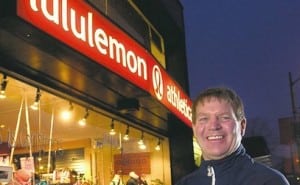
Chip Wilson, founder of yoga apparel and accessories company Lululemon, found himself in an unfortunate situation after being ill prepared for a Bloomberg TV interview.
In case you missed it, the company had to recall its yoga pants after it became quite obvious that its signature product was severely flawed.
The problem? The pants were, in many cases, transparent and were leaving little to the imagination.
Even more transparent than its pants, however, are Wilson’s feelings about the product recall and the product’s real defect.
“Quite frankly, some women’s bodies just actually don’t work,” Wilson told the Bloomberg TV. “It’s about the rubbing through the thighs, and how much pressure is there.”
Wilson blames the out-of-shape consumer and not the product. Not only that, he makes it clear that Lululemon pants aren’t for everyone. In other words, its pants are for consumers in peak physical condition, and not individuals who may be burdened by their thighs rubbing together when they walk.
His comments were shortsighted and likely made media training professionals cringe. He did follow up his television appearance with a video apology; however, he pretty much failed to apologize for any of his controversial comments, instead saying he was sorry for his “actions.”
When thinking about Wilson, his TV interview and his follow-up apology, it raises questions about categorizing his persona. To clarify, Andrew Gilman, President and CEO at CommCore Consulting Group, identifies four character profiles for CEOs.
The classification is important because it helps PR pros to adopt a media-training program that matches a CEO’s character. Although Wilson is not the CEO, he is the founder and a brand spokesperson. With that in mind, read these four profiles and decide: Which profile fits Wilson and, for that matter, which profile fits your CEO?
▶ The Iconoclast: This type of leader is an entrepreneur who is successful while breaking conventions. Consider two Marks: Facebook’s Zuckerberg and Cuban of the Dallas Mavericks.
Achilles’ heel: Bending or breaking a few rules.
The Fix: A rapid response PR team that can snap into action when the CEO misfires. Find a board member or outside consultant who can rein in the CEO without diminishing their flair and enthusiasm.
▶ The Father Figure: Think chicken and burgers—Purdue’s Frank Purdue and Wendy’s Dave Thomas, and of course in finance, Warren Buffett from Berkshire Hathaway.
Achilles’ heel: It’s either the fear factor or Founders Syndrome. Transitioning to new management from successful trusted founders and father figures causes unease among stakeholders.
The Fix: Work with the board to develop a step-by-step transition plan well before the CEO decides to leave. PR needs to make this plan public—and make sure the departing CEO truly gets behind the successor via speeches and media appearances.
▶ The Risk Taker: Leaders whose personal life poses a risk to the organization or company. Unfortunately, many CEOs and politicians fit this category. Two examples: HP’s former CEO, Mark Hurd, and former New York Gov. Eliot Spitzer.
Achilles’ heel: Ask why the leader’s brains are in their heel or in other body parts. The flaw is that they never think they will get caught.
The Fix: Boards should conduct better due diligence and background checks before offering a job. Periodic ethics training doesn’t hurt either.
▶ The Cult CEO: A leader who is so closely linked to the brand’s DNA that it inspires virtual blind loyalty from employees and consumers. The late Steve Jobs and Martha Stewart are examples.
Achilles’ heel: A personal issue that can cause calamity in the kingdom.
The Fix: It’s hard. Develop a crisis plan that anticipates such big events and can de-couple or “unstick” the idealized CEO from the brand.
Learn more about media relations and media training best practices from PR News' Media Relations Guidebook.
Follow Caysey Welton: @CayseyW
